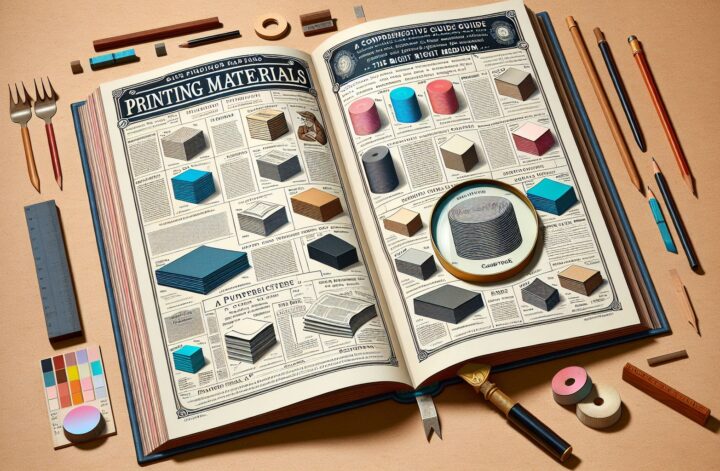Introduction
Printed materials have been an integral part of human communication for centuries. From ancient cave paintings to modern digital screens, materials used for printing have evolved significantly. With advancements in technology, we have seen a shift from traditional paper-based materials to a wide range of substrates including plastics, textiles, metals, and even 3D printing materials. In this article, we will delve into the fascinating world of printing materials, exploring their history, types, and the impact they have had on various industries.
Body
1. The Early Days: Paper as the Pioneer
Paper is undoubtedly the most well-known and widely used printing material throughout history. The invention of paper in ancient China revolutionized the way information was recorded and transmitted. Initially made from bamboo fibers, papermaking spread to the Islamic world and Europe, leading to increased literacy rates and the democratization of knowledge.
2. The Renaissance of Materials: From Parchment to Vellum
Before paper, medieval scribes used animal skins like parchment or vellum for writing. These materials were expensive, primarily made from sheepskin or calfskin, and required meticulous preparation. Parchment and vellum were favored for their durability, allowing documents to survive for centuries.
3. The Industrial Revolution and the Birth of Modern Printing
The Industrial Revolution in the 18th century brought significant advancements in printing technology. With the invention of the printing press by Johannes Gutenberg, paper became more affordable and accessible to the masses. This marked a turning point in history, empowering the spread of ideas, literature, and education worldwide.
4. Digital Age: The Rise of New Printing Materials
As we entered the digital age, the definition of printing materials expanded beyond traditional paper. Today, several innovative materials are used for printing, each serving unique purposes. Let’s explore some of the prominent ones:
a. Plastics
Plastics such as polyethylene, polypropylene, and polystyrene have gained popularity due to their durability, versatility, and cost-effectiveness. Plastic pouches, labels, and packaging materials have become essential in numerous industries. Moreover, advancements in polymer technology have given rise to 3D printing, enabling the creation of complex three-dimensional objects using various plastics.
b. Textiles
Textile printing materials have evolved drastically, leading to a revolution in the fashion and home decor industries. Fabrics like cotton, silk, polyester, and even sustainable materials like bamboo and hemp can now be printed with vibrant designs using advanced techniques like sublimation or screen printing. This has allowed for personalized clothing, interior decorations, and custom branding products.
c. Metals
In industrial applications, printing on metals has become a common practice. Aluminum, stainless steel, and alloys can be printed upon to create labels, signage, or even intricate metal parts. Metal printing techniques like laser marking, etching, or direct metal printing have gained popularity for their durability, resistance to harsh environments, and ability to withstand extreme temperatures.
d. Digital Screens
In today’s digital age, printing materials have expanded to include various electronic display technologies. LCD screens, LED displays, and e-paper have become commonplace, replacing traditional paper-based materials in sectors such as advertising, signage, and e-readers. These digital screens offer dynamic content, remote updates, and interactive capabilities, transforming the way information is presented.
5. Impact of Printing Materials on Industries
The evolution and diversity of printing materials have had a profound impact on several industries:
a. Publishing and Advertising
The shift to digital screens and online publishing has disrupted traditional print media, forcing publishers and advertisers to adapt to the changing landscape. However, the availability of diverse printing materials has also provided new opportunities for creative advertising campaigns and interactive content.
b. Manufacturing and Prototyping
The emergence of 3D printing technology has revolutionized manufacturing and prototyping processes. With a wide range of printable materials, including plastics, metals, ceramics, and composites, designers and engineers can quickly create prototypes and even produce final products on-demand, reducing costs and lead times.
c. Fashion and Textile Industry
The ability to print custom designs on textiles has transformed the fashion and textile industry. It allows designers to express their creativity without limitations and enables mass customization, reducing waste and inventory costs. Additionally, eco-friendly materials like organic cotton or recycled polyester offer sustainable alternatives in fashion.
d. Electronics and Displays
The development of flexible displays has opened up new possibilities in the electronics industry. Devices like curved screens, foldable smartphones, and flexible e-paper are made possible through advancements in printing materials. These materials enable manufacturers to create lightweight, portable, and visually stunning electronic devices.
Conclusion
From humble beginnings with paper and parchment to the vast array of printing materials available today, the evolution of printing has significantly impacted human communication. The advancements in materials have not only expanded our creativity and made information more accessible, but they have also transformed industries and shaped the way we live our lives. As technology continues to advance, we can anticipate further developments in printing materials, leading to exciting possibilities and innovations in the future.

